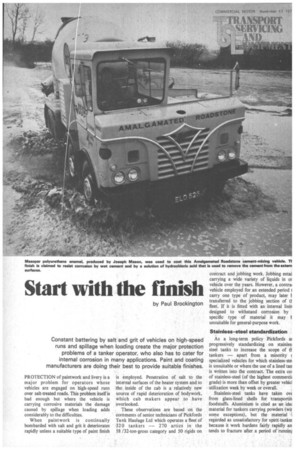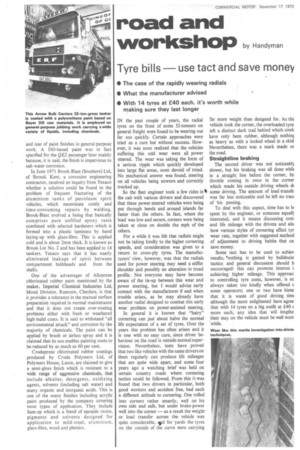Start with the finish
Page 102

Page 103

Page 104

If you've noticed an error in this article please click here to report it so we can fix it.
by Paul Brockington Constant battering by salt and grit of vehicles on high-speed runs and spillage when loading create the major protection problems of a tanker operator, who also has to cater for internal corrosion in manly applications. Paint and coating manufacturers are doing their best to provide suitable finishes.
PROTECTION of paintwork and livery is a major problem for operators whose vehicles are engaged on high-speed runs over salt-treated roads. This problem itself is bad enough but where the vehicle is carrying corrosive materials the damage caused by spillage when loading adds considerably to the difficulties.
When paintwork is continually bombarded with salt and grit it deteriorates rapidly unless a suitable type of paint finish is employed. Penetration of salt to the internal surfaces of the heater system and to the inside of the cab is a relatively new source of rapid deterioration of bodywork, which cab makers appear to have overlooked.
These observations are based on the Comments of senior technicians of Pickfords Tank Haulage Ltd which operates a fleet of 320 tankers -270 artics in the 113 /32-ton-gross category and 50 rigids on
contract and jobbing work. Jobbing entai carrying a wide variety of liquids in or vehicle over the years. However, a contra vehicle employed for an extended period 1 carry one type of product, may later t transferred to the jobbing section of tt fleet. If it is fitted with an internal linir designed to withstand corrosion by specific type of material it may t unsuitable for general-purpose work.
Stainless -steel standardization
As a long-term policy Pickfords ai progressively standardizing on stainles steel tanks to increase the scope of ti tankers — apart from a minority specialized vehicles for which stainless-st& is unsuitable or where the use of a lined tan is written into the contract. The extra co of stainless-steel (of the highest commerd grade) is more than offset by greater vehic] utilization week by week or overall.
Stainless-steel tanks have taken óvt from glass-lined shells for trausportin foodstuffs. Aluminium is cited as an idel material for tankers carrying powders (wit some exceptions), but the material regarded as unsatisfactory for spirit tankei because it work hardens fairly rapidly an tends to fracture after a period of rurinim lpirit has a "searching" property and eadily leaks through minor cracks in nter-compartment bulkheads, although the ame tanker may prove leak-proof when :arrying a different type of liquid or a powder.
Pickfords say that hydrochloric acid and :s derivatives together with oleum (fuming .cid) can be carried in a mild-steel tank .ned with rubber, but that it is impossible to get the acid out of the rubber" and the ank can be employed only for the one iroduct. Chlorinated rubber provides Adequate protection for a tanker carrying alt in powder form.
The main disadvantages of hard rubber is hat it tends to chip around the manways; he company plans to try out soft rubber, ihich would resist abrasion. While poxy-lined tanks are suitable for eneral-purpose applications to a limited xtent, in that the material is resistant to orrosion in the case of some hazardous quids, tanks lined with this material will be :placed by stainless-steel shells apart from pplications to tanks carrying phosphoric cid; employing stainless-steel or rubberned tanks is "inadvisable" for this purpose. Although a mild-steel tank may be aitable for carrying a range of liquids, icluding spirit, and corrosion is no problem 'hen the vehicle is used continuously, the isting rate is high if it is left empty for a onsiderable time. While a PTFE lining is minently satisfactory for carrying many igh-intensity acids, it is very costly and ifficult to apply.
The MEK (methyle-ethyl-ketone) family f solvents has a more "searching" property an that of petroleum spirit and cannot atisfactorily be carried in a rubber-lined Ink. Abrasion rather than corrosion is the iggest offender in many applications, brasion being caused by sediment in the Ink.
lepainting No paint has been found that is capable f resisting rapid corrosion by sulphuric, itric and hydrochloric acids or oleum in le event of spillage (which is virtually ievitable) and a number of leading paint panufacturers has confirmed the nonvailability of a suitable paint finish. ickfords' tankers are normally repainted very three years, 18 months if the vehicle is ansporting high-intensity acids. Excessive )illage may necessitate repainting after tree months.
One-pack polyurethane paint is cited as a good paint for normal wear and tear". The se of acrylic paint will be investigated in
due course as a possible means of increasing the period between repaints.
Pickfords are critical of typical vehicle cabs because of the early onset of rusting at the welded joints, which is attributed to new methods of construction and the more extensive use of welding. Glass-reinforced plastic cabs are not favoured, partly because the cost of painting and paint maintenance is increased; and they are "very expensive" to repair.
Big bang danger
Highly-specialized jobs that Pickfords have in prospect include carrying sulphur trioxide (S03) in a lead-lined mild-steel tanker. If SO, is mixed with water (H20) it forms 1-1,SO4, heat is generated and there is, in Pickfords' words, one hell of a big bang. That's the problem, not the lining. The weight of lead reduces the payload to a small percentage of the load that could be carried if there were no lining.
Resistance to dilute solutions of hydrochloric acid is included in the properties claimed for Masopar Polyurethane enamel by its manufacturer, Joseph Mason and Co Ltd, of Nottingham Road, Derby. The paint is a quick-drying one-pack enamel and was introduced three years ago to provide a finish for road vehicles, notably tankers, in order to offer a higher resistance to corrosion by chemicals in the atmosphere and to corrosion and abrasion by road salt than offered by conventional alkyd-based enamels.
Particular mention is made by Mason of an application to an Amalgamated Roadstone cement-mixing vehicle which resists corrosion by wet cement and, of special importance, to a solution of hydrochloric acid that is used to remove the cement from external surfaces. Mason points out that aqueous salt solutions are electrolytic, which aids the corrosive action of road salt on steel, and that the tonnage of salt used as a road de-icing medium increased from around 900,000 tons in 1965 to 1.4m tons in 4971.
Co nfirm ng the Pickfords' view that abrasion by salt particles (and their penetration into the vehicle) creates one of the most common paint protection problems when a vehicle is continuously engaged on motorway operations, Mason emphasizes that resistance to continuous bombardment by road grit as well as salt is an essential property of a paint finish. It is claimed that hot spray application of Maso par, starting with bare metal, can be completed ready for lettering in six hours.
Bayer Chemicals Ltd, of Bayer House, Richmond, Surrey, give the example of the application by Manchester Tankers Ltd of the Bayer Desmodur-Desmophen (DD) two-pack polyurethane paint to waste disposal tankers as proof of the paint's high resistance to chemical corrosion and to abrasion. Supplied by A. Marcel Guest Ltd of Manchester, DD in this instance was sprayed over conventional paint following the application of Epilife Primer which gives the required key for bonding the polyurethane paint. The wastes carried by Manchester Tankers include acids, solvents, oil, sludge, spirits and other chemically aggressive factory materials including paper pulp and paper saturated with printing inks. It is claimed that some treated tankers have been operating for three years without needing a respray and without colour fade.
DD finish artic Tanker A 32-ton-gross articulated tanker was exhibited at the Earls Court Commercial Motor Show on the Universal stand that had a Bayer DD paint finish, supplied by T. and R. Williamson Ltd, of Ripon. DD paint was specified by the operators, Arrow Bulk Carriers Ltd, to provide resistance to paint corrosion in general-purpose jobbing work that includes the carriage of oils of all kinds, tallows, waxes, additives, detergents, non-corrosive chemicals and latexes. This involves frequent tank washing and cleaning which can be the main cause of rapid wear and tear of paint finishes in general-purpose work. A DD-based paint was in fact specified for the QE2 passenger liner mainly because, it is said, the finish is impervious to salt-water corrosion.
In June 1971 Brook-Blast (Southern) Ltd, of Strood, Kent, a corrosion engineering contractor, received an inquiry from Texaco whether a solution could be found to the problem of frequent fracturing of the aluminium tanks of petroleum spirit vehicles, which necessitate costly and time-consuming repairs by welding. Brook-Blast evolved a lining that basically comprises pure unrifled epoxy resin combined with selected hardeners which is formed into a plastic laminate by hand laying-up with glass-fibre. This is applied cold and is about 2mm thick. It is known as Brook-Lin No. 2 and has been applied to 14 tankers. Texaco says that it has nearly eliminated leakage of spirit between compartment bulkheads and from the shells.
One of the advantages of Alloprene chlorinated rubber paint mentioned by the maker, Imperial Chemical Industries Ltd, Mond Division, Runcorn, Cheshire, is that it provides a tolerance in the manual surface preparation required in normal maintenance and that it does not create over-coating problems either with fresh or weathered high-build coats. It is said to withstand "all environmental attack" and corrosion by the majority of chemicals. The paint can be applied by brush or airless spray and it is claimed that its use enables painting costs to be reduced by as much as 60 per cent.
Crodaprene chlorinated rubber coatings produced by Croda Polymers Ltd, of Polymers House, Luton, are claimed to give a semi-gloss finish which is resistant to a wide range of aggressive chemicals, that include alkalies, detergents, oxidizing agents, solvents (including salt water) and many organic and inorganic acids. This is one of the many finishes including acrylic paint produced by the company covering most types of application. They include Sum-ep which is a blend of epoxide resins, pigments and solvents designed for application to mild-steel, aluminium. glass-fibre, wood and plastics.
































































































































































